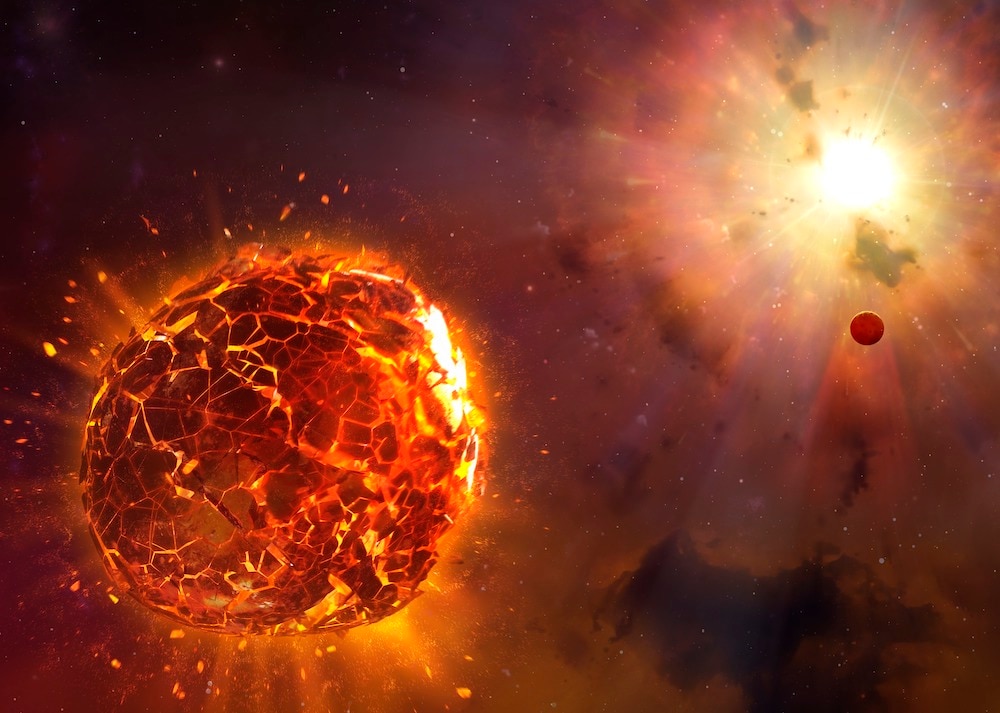Create a free profile to get unlimited access to exclusive videos, sweepstakes, and more!
How do the dying gasps of stars breathe life into Earth?
Supernovas give us life, and it's no oxymoron.

We are carbon-based life-forms. Everything that is alive on Earth is a carbon-based life-form. So why have supernovas, dying stars that explode with lethal radiation, kept us alive?
It’s because of the carbon — and the oxygen it brings. There is an eerily close connection between organic matter in sediment here on earth and changes in supernova occurrence during the last 3.5 billion years. But wait. Faraway supernovas have an impact on the climate, which affects nutrients across the planet. Meaning, the conditions life on Earth needs to exist are determined by a phenomenon that sounds more like a cosmic grim reaper.
There is no way Earth would survive a supernova that spewed killer radiation right in its face, but more distant star deaths have actually given us life. Carbon makes up organic substances, an indirect source of oxygen, since photosynthesis is fueled by organics and its absence would mean our death. This is why researcher Henrik Svensmark believes that supernovas (again, indirectly) let us breathe. He led a study recently published in Geophysical Research Letters.
“The climate on Earth closely follows changes in supernova rates,” he told SYFY WIRE. “Supernova rates affect the intensity of cosmic radiation reaching the Earth. We now have a theory explaining how cosmic radiation connects to the climate.”
When gargantuan stars that are at least 8 times the mass of the Sun gasp their last, the explosions from such massive objects create a shock front in the interstellar medium, or all the gas and dust floating around between stars outside our solar system. Shock fronts happen during a disturbance like a supernova. Because pressure goes beyond a certain minimum, a massive shock wave, or shock front, will form at the head of the disturbance, which rapidly expands. Shock fronts immensely accelerate particles that find their way over here.
After a supernova, particles such as protons scatter across interstellar space, and some do make it into the solar system and journey all the way to Earth’s atmosphere. Clouds in our atmosphere regulate how much radiation from the Sun gets through. This is why the particles in cosmic rays belched out by supernovas are important. These particles ionize other particles in the atmosphere, adding or knocking out electrons and giving them a charge that allows them to form cloud condensation nuclei (CCN) that are needed for water to condense into droplets.
“As these exert a strong cooling effect, increases or decreases in the cosmic ray influx and in cloudiness can significantly lower or raise the world’s mean temperature,” Svensmark said. “This is the central hypothesis. More cosmic rays means more clouds and a colder climate.”
This doesn’t mean a freezing climate. Earth has a colder climate, especially when you compare it to scorchers like Venus, and that means more winds and ocean mixing, which carry sediment with organic substances and nutrients (such as phosphates, iron, and zinc) to ecosystems. Because cold climates have huge differences between temperatures in the tropics and the poles, that pushes mixing and the spreading of nutrients, and higher levels of nutrients mean more life can be sustained. This is something that doesn’t happen much on planets with warm climates. It might be one of the reasons many don’t appear habitable.
Having enough nutrients to support life on Earth is a side effect of supernovas. Many can be found as trace elements in pyrite, which gives away the time period when these nutrients were present in the oceans and how much of them there was. Organic material that is buried in sediments keeps photosynthesis going and therefore gives us oxygen. Finding out how much organic material was in the sediment back then means comparing carbon-12, the isotope carbon life favors, to carbon-13, a heavier carbon isotope that isn’t nearly as common.
“These measurements span almost 4 billion years and make it possible to calculate the fraction of organic matter in sediments,” said Svensmark. “There is an excellent agreement with the supernovae rates, supporting the connection between supernovae and life on Earth.”
Just in case you think that this life-giving force could be extinguished, don’t worry about supernovas going quiet anytime soon, because stars we don’t see are constantly blowing up.


























